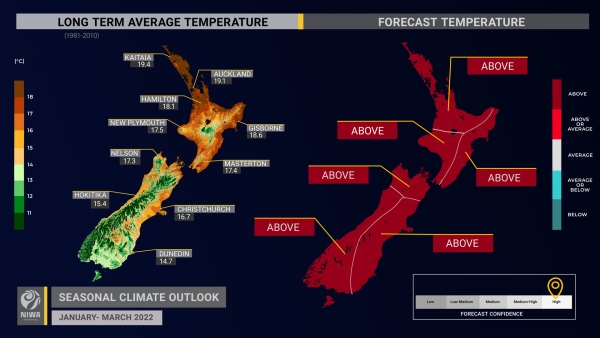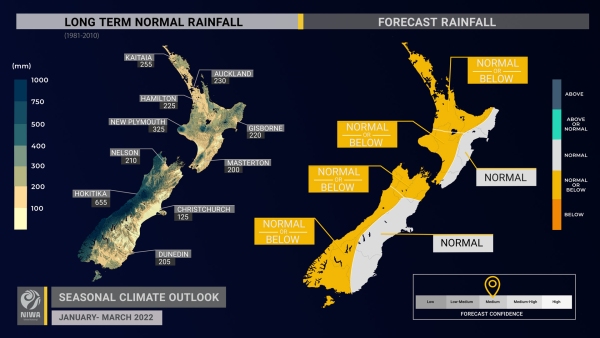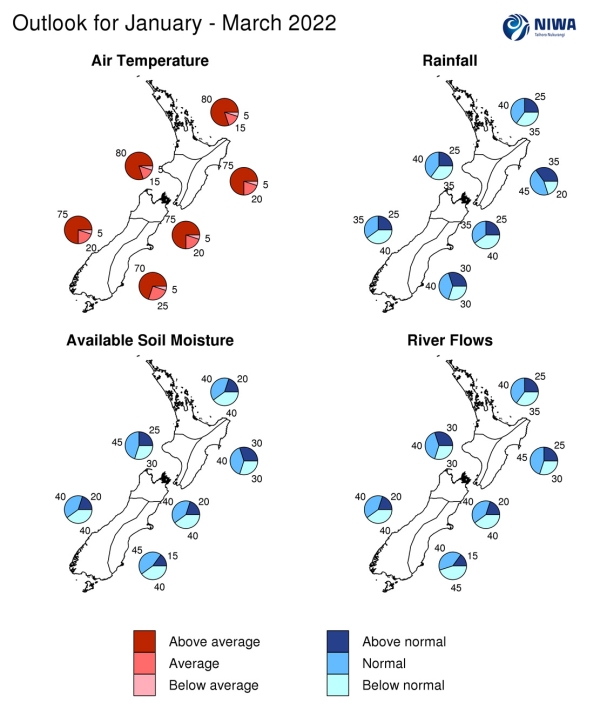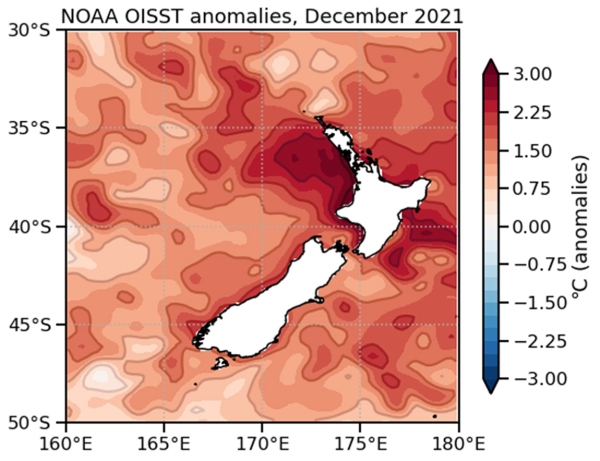Outlook summary
- La Niña conditions strengthened in the equatorial Pacific during December. It is expected to continue to be a key climate driver for Aotearoa New Zealand over the next three months, with an 80% chance for its continuation. For more information, see the Background.
- Marine heatwave (MHW) conditions intensified in New Zealand’s coastal waters during December. NZ’s coastal sea surface temperatures ranged from 1.6˚C to 2.5˚C above average. This is expected to continue to have a strong upward influence on air temperatures and humidity. For the northern North Island, the magnitude of the MHW surpassed the previous record-breaking event of summer 2017-18. In the western and eastern North Island, the event has been consistent with summer 2017-18.
- Air pressure is forecast to be higher than normal in the New Zealand region and lower than normal to the north of the country. This is expected to be associated with more northeasterly quarter winds than normal, consistent with La Niña conditions.
- For the next three months as a whole, temperatures are very likely to be above average across the country. Warm nights and periods of high humidity will continue to be a factor. Sub-tropical northeasterly winds and a lack of southerly fronts may mean that cooler than average temperatures occur quite infrequently. However, eastern areas of both islands may experience a reduction in hot days due to more frequent onshore winds.
- Rainfall is most likely to be near normal in the east of both islands and about equally likely to be near normal or below normal in all other regions. Extended periods of higher than normal air pressure may influence long dry spells, particularly about the interior and west of both islands. Predominant onshore winds in the east of both islands may influence more cloud cover and drizzly days.
- Tropical cyclone activity is likely to the north of the country during January. New Zealand has an elevated risk for cyclone activity through April. As was experienced during December, moisture from ex-tropical cyclones can increase the risk for flooding. Marine heatwave conditions may contribute more moisture for weather systems to tap into as they approach the country.
- Soil moisture levels and river flows are most likely to be near normal in the west and east of the North Island and about equally likely to be near normal or below normal in all other regions.
Regional predictions for January – March 2022
Northland, Auckland, Waikato, Bay of Plenty
The table below shows the probabilities (or percent chances) for each of three categories: above average, near average, and below average. In the absence of any forecast guidance there would be an equal likelihood (33% chance) of the outcome being in any one of the three categories. Forecast information from local and global guidance models is used to indicate the deviation from equal chance expected for the coming three-month period, with the following outcomes the most likely (but not certain) for this region:
- Temperatures are very likely to be above average (80% chance). Due to marine heatwave conditions, periods of excessive humidity and hot temperatures are more likely.
- Rainfall totals are about equally likely to be near normal (40% chance) or below normal (35% chance). Periods of high pressure will likely cause extended dry spells; however, an elevated chance for ex-tropical cyclone activity can increase the risk for heavy rainfall events.
- In early January, unusually dry conditions emerged in parts of Northland and Waikato according to NIWA’s New Zealand Drought Index.
- Soil moisture levels and river flows are about equally likely to be near normal (40% chance) or below normal (35-40% chance).
The full probability breakdown is:
|
Temperature |
Rainfall |
Soil moisture |
River flows |
|
|
Above average |
80 |
25 |
20 |
25 |
|
Near average |
15 |
40 |
40 |
40 |
|
Below average |
05 |
35 |
40 |
35 |
Central North Island, Taranaki, Whanganui, Manawatu, Wellington
Probabilities are assigned in three categories: above average, near average, and below average.
- Temperatures are very likely to be above average (80% chance). Due to marine heatwave conditions, periods of high humidity and hot temperatures are more likely.
- Rainfall totals are about equally likely to be near normal (40% chance) or below normal (35% chance). Periods of high pressure will likely cause extended dry spells; however, an elevated chance for ex-tropical cyclone activity can increase the risk for heavy rainfall events.
- Soil moisture levels and river flows are most likely to be near normal (40-45% chance).
The full probability breakdown is:
|
Temperature |
Rainfall |
Soil moisture |
River flows |
|
|
Above average |
80 |
25 |
25 |
30 |
|
Near average |
15 |
40 |
45 |
40 |
|
Below average |
05 |
35 |
30 |
30 |
Gisborne, Hawke’s Bay, Wairarapa
Probabilities are assigned in three categories: above average, near average, and below average.
- Temperatures are very likely to be above average (75% chance). Due to marine heatwave conditions, periods of high humidity and warm overnight temperatures are more likely. An increased frequency of onshore winds may reduce the number of hot days, however.
- Rainfall totals are most likely to be near normal (45% chance). An elevated chance for ex-tropical cyclone activity can increase the risk for heavy rainfall events, particularly across Gisborne and northern Hawke’s Bay.
- Soil moisture levels and river flows are most likely to be near normal (40-45% chance).
The full probability breakdown is:
|
Temperature |
Rainfall |
Soil moisture |
River flows |
|
|
Above average |
75 |
35 |
30 |
25 |
|
Near average |
20 |
45 |
40 |
45 |
|
Below average |
05 |
20 |
30 |
30 |
Tasman, Nelson, Marlborough, Buller
Probabilities are assigned in three categories: above average, near average, and below average.
- Temperatures are very likely to be above average (75% chance). Due to marine heatwave conditions, periods of high humidity and hot temperatures are more likely.
- Rainfall totals are about equally likely to be below normal (40% chance) or near normal (35% chance). Periods of high pressure will likely cause extended dry spells; however, an elevated chance for ex-tropical cyclone activity can increase the risk for heavy rainfall events.
- Soil moisture levels and river flows are equally likely to be near normal (40% chance) or below normal (40% chance).
The full probability breakdown is:
|
Temperature |
Rainfall |
Soil moisture |
River flows |
|
|
Above average |
75 |
25 |
20 |
20 |
|
Near average |
20 |
35 |
40 |
40 |
|
Below average |
05 |
40 |
40 |
40 |
West Coast, Alps and foothills, inland Otago, Southland
Probabilities are assigned in three categories: above average, near average, and below average.
- Temperatures are very likely to be above average (75% chance). More common offshore winds may increase the frequency of hot days along the West Coast.
- Rainfall totals are about equally likely to be below normal (40% chance) or near normal (35% chance).
- Patterns of high pressure near the South Island may contribute to drier conditions around the hydro lake areas. Particularly dry conditions are probable during January.
- As of early January, unusually dry or very dry conditions were occurring in southern Otago, eastern Southland, and Stewart Island according to NIWA’s New Zealand Drought Index.
- Soil moisture levels and river flows are equally likely to be near normal (40% chance) or below normal (40% chance).
The full probability breakdown is:
|
Temperature |
Rainfall |
Soil moisture |
River flows |
|
|
Above average |
75 |
25 |
20 |
20 |
|
Near average |
20 |
35 |
40 |
40 |
|
Below average |
05 |
40 |
40 |
40 |
Coastal Canterbury, east Otago
Probabilities are assigned in three categories: above average, near average, and below average.
- Temperatures are very likely to be above average (70% chance). Due to marine heatwave conditions, warm overnight temperatures are more likely. An increased frequency of onshore winds may reduce the number of hot days, however.
- Rainfall totals are most likely to be near normal (40% chance). Predominant onshore winds may influence more cloud cover and drizzle.
- Soil moisture levels and river flows are about equally likely to be near normal (40-45% chance) or below normal (40-45% chance).
The full probability breakdown is:
|
Temperature |
Rainfall |
Soil moisture |
River flows |
|
|
Above average |
70 |
30 |
15 |
15 |
|
Near average |
25 |
40 |
45 |
40 |
|
Below average |
05 |
30 |
40 |
45 |
Graphical representation of the regional probabilities
Background
The NINO3.4 Index anomaly (in the central Pacific) over the last month (through 2 January) was -0.68˚C, near the La Niña threshold. The monthly Southern Oscillation Index (SOI) was +1.3 and the three-month average SOI was +1.0, both in the La Niña range.
Upper-oceanic heat content continued to be below normal in the central and eastern equatorial Pacific, associated with the peak of a La Niña event. In the subsurface, anomalies of -1˚C to -2˚C continued at depth in the central and east. In the west, a substantial warm pool of water (+3˚C to +4˚C) developed between 150-200 m depth. This feature, likely spurred by enhanced westerly winds north of Papua New Guinea, will be monitored in the coming months as La Niña wanes and most likely gives way to ENSO neutral conditions.
The Southwest Pacific Convergence Zone was again displaced southwest of its climatological position, consistent with La Niña.
La Niña conditions remain favoured during January-March (80% chance). Between April-June, there is a 70% chance for the re-emergence of ENSO neutral conditions. During July-September, ENSO neutral is favoured at a 50% chance.
During December, convective forcing was focused over the Maritime Continent, western Pacific, and Africa. This was influenced by the low frequency forcing state associated with La Niña, a slow-moving pulse of the Madden-Julian Oscillation (MJO), and an atmospheric Kelvin Wave. The MJO will continue to be active over the western Pacific (phase 7), particularly during the first half of January. The second half of the month may feature more activity over Africa and the western Indian Ocean (phases 1+2).
For New Zealand, phase 7 during January has historically been associated with warmer than average temperatures for most of the country aside from the east of both islands.
Heading into February, there is an indication that the MJO will be more active in the Indian Ocean (phases 2+3). This has been associated with warmer than average temperatures in New Zealand while rainfall has tended to be below normal in the North Island and parts of the northern and eastern South Island.
The Southern Annular Mode (SAM) was positive for the duration of December. After a brief period of neutral SAM in early January, a trend toward strongly positive values is again expected as higher than normal pressure is favoured in the New Zealand region.
Marine heatwave (MHW) conditions intensified in New Zealand’s coastal waters during December. Sea surface temperature anomalies ranged from +1.6˚C to +2.5˚C for the month as a whole, although daily anomalies reached as high as +4.0˚C to +5.0˚C near the northern North Island. This is expected to continue to have a strong upward influence on air temperatures and humidity and may provide more moisture for weather systems to tap into as they approach the country. Those with interests in New Zealand’s marine environment should remain alert of the latest updates through the season. Climate models indicate that MHW conditions will ease by autumn.
NZ coastal SST anomalies (through 31 December)
|
North NI |
2.31˚C |
|
West NI |
2.51˚C |
|
East NI |
1.92˚C |
|
North SI |
1.73˚C |
|
West SI |
1.92˚C |
|
East SI |
1.61˚C |
Forecast confidence
Temperature
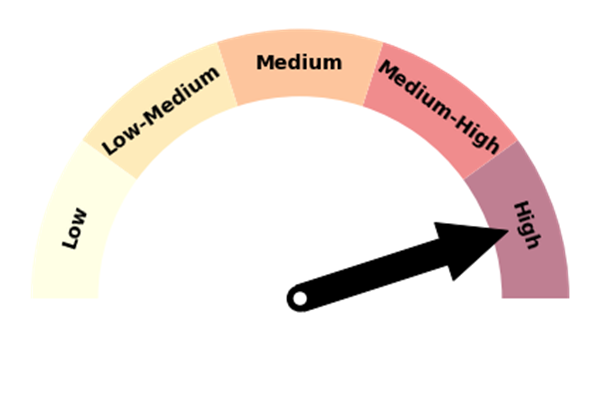
|
Forecast confidence for temperatures is high. The continuation of marine heatwave conditions and La Niña, more sub-tropical winds, and higher than normal air pressure all favour warmer than average temperatures over the three-month period. The likelihood for a positive Southern Annular Mode may limit the frequency of southerly fronts. Most of the climate models that NIWA surveys indicate a warmer than average January-March. |
Rainfall
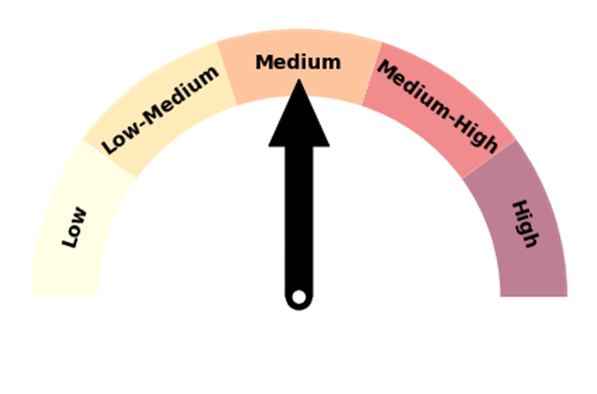
|
Forecast confidence for rainfall is medium. Higher than normal air pressure is forecast to commonly hover near New Zealand, particularly about the South Island. This can influence extended dry spells. However, with the potential for activity in the tropics, New Zealanders should remain vigilant for local impacts (e.g., heavy rainfall / flooding), particularly in the North Island and northern and eastern South Island. One of these systems can quickly change the complexion of a season. |

